The goal is to steer you toward value by focusing on steps that are low cost
or high benefit; some are both. For those projects you’ll do yourself, I offer
tools and tips from 18 years of direct experience in helping people save energy and improve comfort.
For those projects that need outside help, I’ll teach
you what to look for in a contractor, what to ask him or her to do, and what
to expect. Some steps aren’t projects at all, but simply ask you to pay a bit
more attention, by smart shopping, planning ahead, or making yourself more
aware of your day-to-day use of the energy-consuming “stuff” in your home.
What to tackle first? Every house is different, and so is every family, so there’s no recipe for the “right” solution. Before we start looking at the projects themselves, we’ll talk about the house as a series of systems, and the ways these systems use energy Understanding your energy use will help you create a strategy that works for you and will help you capitalize on opportunities to reduce costs or leverage benefits whenever you are doing other remodeling work on your house. I’ll provide an overview of environmental impact and health and safety concerns right in your home. Then I’ll show you how to get outside help when you need it: financial help, technical help, and contractor help. This will help you plan ahead so you can get the maximum benefit from these steps and projects at a minimum cost and effort.
TIP: Your house is a system. The systems in your house are supposed to work together to provide you with a safe, comfortable place to live. When the entire system is working properly, each smaller system makes its contribution, but when one component doesn’t do. Its job, it can throw off the entire system. That can affect your energy bills, as well as your comfort, health, safety, and home maintenance bills.
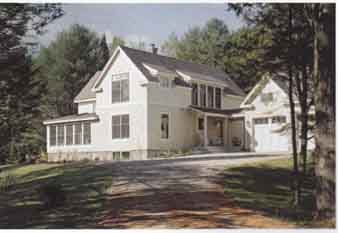
Increasing the energy efficiency of your house can
be as involved as installing a solar water heater, or as simple as sealing
windows and doors with weather-stripping.
Think of Your House as One Big System
Your house is a machine for living; a big system made of smaller systems. Each plays its part in the performance of the whole; each affects your well-being. Heating, cooling, lighting, layout, and the flow of air and moisture all impact your comfort, health, energy use, and cash flow.
The system can be complex, but consider this simple example: One person in the house regularly bumps the thermostat up a couple of degrees, and another person pushes it back down. Sound familiar? The changes in the thermostat tell the heating or cooling system to turn on or shut off, which has an immediate impact on temperature and comfort, as well as air and moisture flow and energy use.
People’s perceptions of comfort affect their actions. Yet perceptions are only the tip of the iceberg. In this section, I explain the main systems we’ll be considering in this guide: electrical systems, heating, cooling, water heating, the building enclosure, and a few of the ways that things can go wrong.
UNDERSTAND YOUR ENERGY COSTS (SuperTip 1)
In 2008, the average household spent between $2,100 and $2,500 a year on energy, and costs are rising. (This does not include gasoline for automobiles, yard care, or recreation.)
Those dollars are split about equally between electricity and gas, although for homes using oil for heat, costs are higher—and rising more quickly—than for homes heated with gas. Most analysts agree that energy costs will continue to rise steadily as worldwide demand continues to increase and supplies of fossil fuels tighten.
Energy Expenses by Use—Average per Home

This chart shows the annual expenses, divided by
general categories of use, for the average American home in cold and hot climates. Although the heating and cooling consumption varies, both
the total amounts and the relative sizes of the other categories are
surprisingly steady across climates.
Tip: What are we buying? Most of us would like to see our energy bills go away, but we don’t spend that much time thinking about them. At the end of the month, we are not proud owners of kilowatt-hours and therms; we pay for the comfort and utility we enjoy in our homes. We pay to keep warm in winter, to keep cool in summer, and to have hot running water. We pay for our toast and coffee, our TV and computer, our answering machine and cell phone charger. Conservation implies sacrifice, or at least a willingness to get by with a little less. Efficiency means enjoying the same level of comfort and convenience using less energy. Conservation usually costs nothing; efficiency typically involves an investment. There is a place for both approaches in any effort to save energy, carbon, and money, but the focus of this guide is on efficiency in the house system.
The House as a System
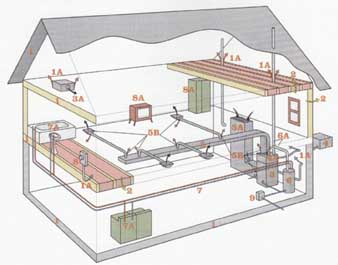
1 The walls, roof, and foundation form the enclosure, or thermal boundary, of the house. Their job is to separate indoors from outdoors, keeping out heat, cold, wind, water, pests, and intruders.
1A Holes in the enclosure create pathways for air, allowing heat or cooling to escape and pests to enter. They can also create paths for the rapid spread of fire, and for moisture to get out or in, where it can condense and cause trouble.
2 Insulation is typically installed in wall cavities, attics, and floors to reduce heat movement (out in the winter and in during the summer). Gaps in insulation allow heat to flow in or out—even where no air is leaking. Cold spots from insulation gaps can create condensation that leads to mold growth.
3 Your heating and cooling systems should maintain comfortable temperatures. The heat is usually supplied by burning gas, although it may be oil, propane, or electric; air conditioners run on electricity.
3A Bathroom and other exhaust fans can compete with a natural-draft furnace or water heater for indoor air; a bathroom fan can dump moisture into the attic.
4 Air conditioners use an outdoor coil or compressor to dump unwanted heat outdoors.
4A The cooling coil (or evaporator) is usually a separate unit mounted in the duct next to your furnace.
5 Supply ducts bring heated or cooled air into the home. Some homes use pipes and radiators, instead of ducts.
5A The return duct(s) bring house air back to the system to be heated or cooled.
5B Holes in ducts let hot or cold air out of the house, reducing comfort and efficiency. These leaks also change the pressure in your home, bringing in soil gases or mold from your basement or carbon monoxide from your garage or heating system, causing ice dams or moisture damage.
6 Your water heater may be powered by gas, electricity, oil, or propane. It may be wasting energy even when you aren’t using hot water.
6A Your water heater or furnace vent system can leak combustion gases, including deadly carbon monoxide, because of air pressures in the house created by exhaust fans or your furnace fan.
7 Plumbing pipes bring hot and cold water to your plumbing fixtures. The fixtures, and the way you use hot water, consume energy.
8 Your electrical system includes a meter, circuit breakers, and wires to bring electricity to lights, appliances, and outlets. It doesn’t use electricity; it only carries it where it’s needed.
8A Large and small appliances use electricity when you are operating them, and sometimes when you aren’t.
9 Your fuel supply system consists of a gas meter and pipes. Like the electrical system, it doesn’t use gas; it only supplies fuel where it’s needed. If you use oil or propane, it is stored in a tank on your property.
How Much Can I Save?
The energy business is full of good news and bad news. The bad news is that your energy usage is probably high; the good news is that there’s potential for real savings. The more you’ve been using, the more you can save.
How much might you save over time? We’ll look at several major factors that influence your savings so you can get an idea. If you want more detailed estimates of savings customized for your house, climate, and past history, a professional energy assessment can guide you.
In most homes, the highest monthly gas bill in the winter is a rough estimate of potential yearly heating savings, for reasonably cost-effective measures, but if your use is very high, you may do better. Your electricity savings could be anywhere from 10 percent to 40 percent of your electric bill, depending on where you start and how far you want to go.
The age of your house is also a big factor. On average, houses built before 1950 use more energy than those from more recent time periods. Older homes weren’t well insulated, and they are more likely to have older, less efficient equipment and appliances. But if your home was built more recently, even within the last few years, there may still be big opportunities for savings. Newer homes are less likely to need wall insulation, windows, or appliance upgrades, but they are equally likely to need air sealing and duct repairs.
Tip: A The EPA and U.S. Department of Energy jointly maintain a website that provides comprehensive information about all the ENERGY STAR programs (www.energystar.gov). See the “Home Improvement” and “Products” sections for the latest information and listings for your home energy needs.
SEPARATE YOUR ENERGY USES (SuperTip 2)
A helpful way to understand your energy use is to compare yours to national averages. It’s also helpful to estimate how much you spend on heating, cooling, water heating, and “other” (mostly lighting and appliances). Though inexact, it may help you find a particular area where you’re unknowingly wasting a lot. (Note: a home-performance professional or auditor can help with this process)
Here’s how to do it:
1 First, gather your electricity and gas bills from the previous year. If you didn’t save them, many monthly bills have a summary of the previous year’s use. If yours doesn’t, request that information from your utility company.
2 Total all the bills (electricity and gas or oil) for the past year, and divide that by the square footage of your house. Compare the total annual energy cost per square foot to the values in the top chart on the facing page. If you use a lot more energy than average, your potential for energy savings is high.
3 Separate your energy use by category. To do this, you need to know what fuel you use for what purpose. Most homes use natural gas for home heating and hot water, and electricity for cooling and “other”—lighting and appliances.
4 Estimate heating and cooling usage by calculating a “baseline” usage for gas and electricity. Find the lowest months of the year, and take their average.
Multiply by 12 to get the annual baseline.
5 If you heat with gas, subtract your gas baseline from the total annual gas bill—that’s what you spend on heating (if you have a gas—fired pool heater, you may have a gas usage peak in the summer as well).
6 Do the same for electricity to get your air-conditioning use; if you have a pool, the increased summer usage would also include the pool pump. Your electricity baseline is typically refrigeration, lighting, and appliances.
7 You may have an increased electricity load in winter, due to higher lighting use, furnace fan operation, or electric heating. In that case, subtract the baseline from the totals of summer and Minter months separately. Note that your water heater, oven/range, or dryer may each run on either gas or electricity.
8 Compare the totals to the chart on below to gauge your use for each of these general categories.

Average Household Energy Costs in Dollars per Square
Foot: In the example, the total annual bill is $2,700, and the space—a
large apartment—is 3,800 sq. ft. The annual energy cost for this apartment
is $71 per square foot, actually a bit lower than the national average
for its size.
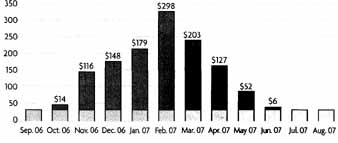
Baseline vs. Heating Gas Usage: The light
green section of the graph shows the baseline use; the dark green shows
the remainder, which is for heating. Note that the bill dates are later
than the month the energy was consumed. The baseline for this year of
gas bills is $32. That’s about $372 for cooking and hot water—the other
gas uses in the home—higher than the average of $288. The remainder, $1,140,
is what this household used for heating; that’s also a bit higher than
the average of $963 for a cold climate.
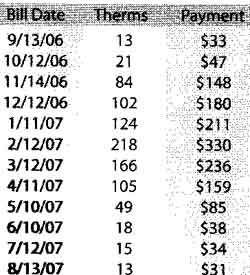
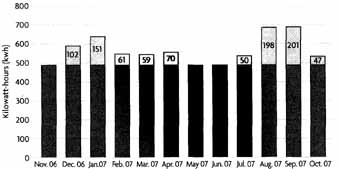
Baseline vs. Cooling Electric Usage: The baseline
for this electric bill is the average of November, May, and June use:
489 kwh. That’s 5,880 kwh per year, or about $91 per month and $1,092
per year. This is higher than the cold climate average of $809 for refrigeration,
lights, and appliances, but not dramatically. Note that there is a winter
increase and a summer increase: The winter increase, a total of 445 kwh,
or $87 for November to April, is most likely the furnace fan and increased
lighting use during the darker months. The summer increase of 497 kwh,
or $80 for July to October, is from air-conditioning; it’s well below
the cold-climate average of $133.
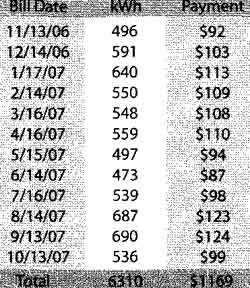
Your Home’s Environmental Impact
Your house and energy use affect the environment in two major ways. In the big picture, energy consumed is responsible for greenhouse gas emissions, such as carbon. There are also many secondary effects, such as the environmental consequences of land use, transportation to and from home, wastewater treatment, and household waste disposal. Closer to home, we’ll consider how your house systems affect the indoor environment, and their direct impacts on you and your family.
THE CARBON IMPACT (SuperTip 3)
Energy use in buildings is responsible for 40 percent of the country’s carbon emissions, which is slightly more than those from transportation. Homes contribute about half of that, and energy use is the culprit.
In most homes, heating and cooling are the biggest energy users. But electricity has the highest carbon emissions—almost 3.5 times that of natural gas (see the chart at left). So if your first concern is climate change, focus on electricity savings: lighting and appliances, air-conditioning, and other electricity uses. You probably can’t get to zero, but you can buy green power or carbon offsets for what you do use (see “Buy Green Power).
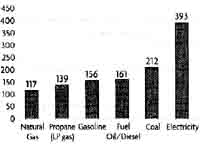
Carbon Emissions of Common Household Fuels:
Natural gas emits the least carbon per unit of the common fossil fuels;
coal has the most. Electricity (national average) has the highest greenhouse
gas impact: First, because conventional power plants are inherently inefficient, and second, because of the high carbon content of coal, which fuels about
half our electric generation.
THE HEALTH IMPACT (SuperTip 4)
Moisture in homes is a contributing factor to respiratory ailments and allergies. Studies by the Environmental Protection Agency (EPA) estimate that more than 20 percent of asthma cases in the United States are attributable to dampness and mold exposure in buildings, costing the health care system (and all of us) $3.5 billion annually.
How does your house affect your health? Control of heat- and airflow in buildings has a strong connection to moisture. This includes controlling condensation and humidity, along with repair of plumbing leaks, roof leaks, and water leaks in walls, as well as controlling moisture in basements. Movement of air can help dry things out, but it can also introduce moisture, which makes controlling airflow important.
Other health concerns include combustion gases and deadly carbon monoxide that can be produced by furnaces, water heaters, ovens, and cars. Air pressures created in homes by the furnace fan and ductwork can draw these gases into the home. Energy efficiency is often wrongly blamed for air quality problems. Efficiency work can indeed cause trouble if implemented carelessly, but when tackled with a systems approach, efficiency strategies can improve your health by effectively controlling heat, air, and moisture.
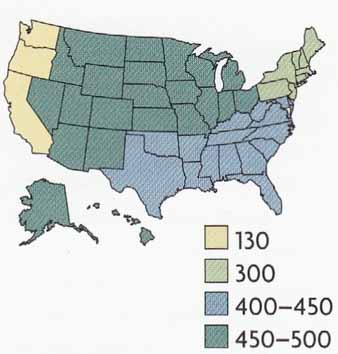
Carbon Emissions of Electricity by Region: Where
you live makes a big difference in the carbon emissions of your electric
supply. On the Pacific coast, emissions are nearly equal to natural
gas, due to the large proportion of hydroelectric and renewable power.
The central Midwest has the highest, due to heavy
dependence on coal.
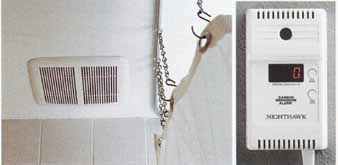
(left) A fan like this is the only fresh-air
ventilation system in most homes, but the average bathroom fan is noisy,
moves little or no air, and runs less than an hour a day. See later
section for tips on improving fresh air and controlling moisture in
your home. (right) Every home should have at least one carbon monoxide
detector. Follow the manufacturer’s recommendations for number and placement.
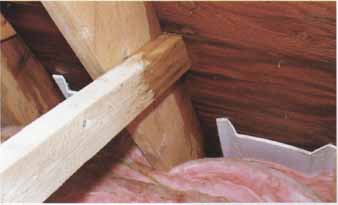
Warm, moist air from the house can leak into attics
or other cold areas and condense on structural components, leading to
rot and mold. Sealing leaks and controlling humidity will reduce or
stop this unwanted moisture.
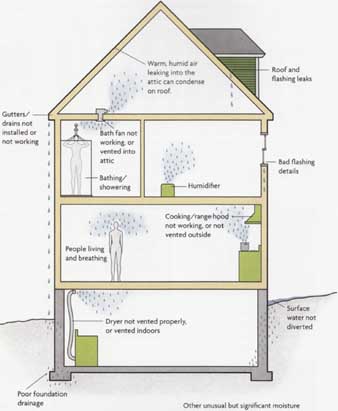
Unwanted Moisture Comes from Inside and Outside:
Other unusual but significant moisture sources include drying firewood,
uncovered tropical fish tanks, or attached greenhouses. Gutters/ drains
not installed or not working; Warm, humid air leaking into the attic can
condense on roof; Roof and flashing leaks; Bad flashing details; Cooking/range
not working, or not vented outside; Surface water not diverted; Dryer
not vented properly, or vented indoors; Poor foundation
drainage.
Getting Some Help
Chances are, as you go through this guide and consider all the projects, you may not know where to start. You’ll find that some projects are too involved to tackle right away. They may take more time, knowledge, technical ability, or funding than you have available right now. Or you may have a special situation that’s not covered here. The good news is that you can get help in several areas: knowledge, implementation, and funding.
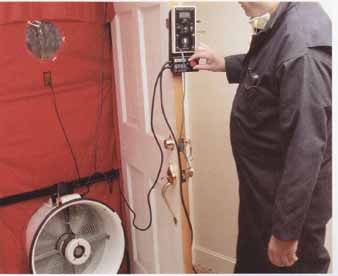
A blower door is a large fan that depressurizes
the home and measures the air leaks using highly sensitive pressure
gauges. It is also a diagnostic tool to identify the locations of leaks.
GET KNOWLEDGEABLE HELP (SuperTip 5)
Despite all the good advice in this guide, consider having a professional assessment of your home. Typically called “energy auditors,” these pros assess your home’s structure, equipment, lighting, and appliances, as well as your lifestyle, to account for where and how the energy is being used. Then the auditor can make specific recommendations for improvements, based on your actual situation.
Historically, utility company audits have been a cursory walk-through, with minimal awareness of the house as a system and limited opportunities for follow— through. You want a consultant who understands the house as a system, brings awareness of related health and safety issues, and can help you strategize your improvement opportunities.
Before hiring an auditor, ask what services he or she provides. Quality auditors will spend several hours in your home, looking carefully in your attic and basement and at your heating and cooling equipment and ductwork. They should perform an air leakage test using a “blower door,” and they should either probe your walls carefully or use an infrared camera to assess the insulation levels and quality.
They may test or carefully inspect your ducts for leaks. They should check your combustion equipment during the visit as well. Most will provide a detailed, computerized analysis of your whole home’s energy performance.
Go Green—Buy Green Power (SuperTip 6) In many areas of the United States, you can purchase green power directly from your electric utility. When you choose the green option, the electric company collects a premium that contributes to a fund that may invest in new solar, wind, small hydro (hydroelectric), or other green electric generation. In that way, your power company can guarantee that the equivalent energy units that you use will be generated somewhere nearby and contribute to the electric grid. Some utilities offer more green power options. If you can’t buy green power through your local utility, you can still purchase equivalent green energy credits through a number of organizations. |

(left) An infrared scan shows missing wall insulation—this
was taken indoors on a cold day. Blue areas show cold spots; yellow
areas show warmer areas of good insulation. Note the slightly cooler
studs (orange), the cold (uninsulated) attic hatch, and the areas around
the hatch where insulation isn’t working well. (right) A professional
borne performance analysis or home energy rating provides a thorough
assessment of your home to help you plan a strategy and focus on the
projects with the most benefit.
Go Green—High performance and EnergyStar (SuperTip 7) Look for Home Performance with ENERGY STAR on the web and in your area. Home Performance with ENERGY STAR is a national model for addressing all your home energy and performance concerns in a unified package, using trained, qualified consultants and contractors. The Environmental Protection Agency sets the standards. Training, marketing support, and quality assurance is typically carried out at the state or utility sponsor level, and it includes some real financial support in some markets. ENERGY STAR The EPA and U.S. Department of Energy jointly maintain a website that provides comprehensive information about all the ENERGY STAR programs . See the ‘Home Improvement” and “Products sections for the latest information and listings for your home energy needs. |
GET HOME PERFORMANCE (SuperTip 8)
There is a movement toward more comprehensive home energy assessments that include diagnostic testing, safety evaluations, and in-depth recommendations based on a performance evaluation of the whole house system.
Two national certification programs exist for professionals that you can trust: the Residential Energy Services Network (RESNETSM) certifies Home Energy Raters, and the Building Performance Institute (BPI) certifies Building Analysts. Both are excellent choices for getting a thorough home performance evaluation. You can also look for a certified Home Performance Analyst recognized by both organizations.

A The Residential Energy Services Network (RESNET) and Building Performance Institute (BPI) provide professional certifications
for Home Energy Raters and residential Building Analysts. These are
the people you want when you need help.
GET HELP WITH THE WORK (SuperTip 9)
Don’t shy away from projects you can’t do yourself because they may be beyond your skill or comfort level. These may be some of the biggest energy savers, and they are worth hiring a contractor who can do the job right.
Many sections in this guide suggest ways to identify qualified contractors for specific types of work. Of course, it’s always a good idea to get multiple bids, but don’t base your decision on price only. Talk to the contractors, find out how they work and what they pay attention to. Get referrals, and ask not only what went well, but how the contractor handled a situation when something went wrong.
GET FINANCIAL HELP (SuperTip 10)
An increasing number of electric and gas utility companies and state agencies offer programs that provide some combination of technical support (audits and assessments), incentives or rebates, or access to attractive financing for energy improvements. Take advantage of all the assistance you can. For income-qualified homeowners, weatherization assistance is generally available through state or local community action agencies. Finally, there are a number of state and federal government tax credits that can help offset some of the cost.
PLAN AHEAD (SuperTip 11)
As with any investment, energy efficiency improvements can benefit from a good plan. You probably won’t do everything at once, but start by prioritizing. Plan on improvements that have a high cost/benefit ratio first, either because you get a lot of savings, or because implementing them is cheap. The savings can literally help you pay for more improvements. If you are inclined toward hands-on work, or want more in-depth information on insulation, heating and cooling systems, renovations, and ventilation systems, you may want to see Insulate and Weatherize.
Think about any equipment or appliances that are getting older—not only are older appliances less efficient, but the time to upgrade at a reasonable cost is when you are already paying to replace worn-out items. and consider plans to remodel or refinish rooms, or to replace exterior systems like siding or roofing. These can provide valuable opportunities to increase your home’s efficiency at a modest additional cost.
Go Green (SuperTip 12) Even as you focus on what’s easily attainable and cost- effective, use the opportunity to do the best you possibly can with each project, large and small. Whether fixing duct leaks and air leaks, adding insulation, replacing a heating or cooling system or your windows, or making a more substantial renovation, it’s extremely unlikely you’ll do this again for years to come. If you plan to stay in the house indefinitely, even improvements that aren’t cost-effective now will pay back faster as energy prices rise, and aggressive energy efficiency will help make your house inflation-resistant. If you don’t stay in the house, these efforts will add value and reduce greenhouse gas emissions for years. When choosing electronics and equipment, you’ll see a theme repeated in this guide: Don’t settle for ENERGY STAR alone, but look beyond for the very highest efficiencies. Stretch as far as you can in every project you do—your planet, and your children, will thank you. |
Next: Lighting and Plug-ins